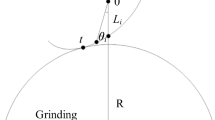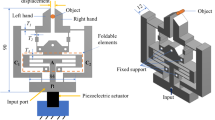Abstract
The problem of error compensation in manufacturing industry becomes important since the product quality is the manufactures’ competition. This paper presents an intelligent self-learning method for dimensional error pre-compensation in CNC grinding. Measurements of the system output obtained from the previous runs are used to compute the correction for the current run without in-process sensing and measurement, which is attractive for applications lacking in situ measurements. A modified NC program is fed to the machine tool to push the system output towards target. The simulation results and the real system input and output responses show the feasibility and effectiveness of this intelligent self-learning method.
Similar content being viewed by others
References
Fan KC, Lee MD (2002) Mou JI, On-line non-contact system for grinding wheel wear measurement. Int J Adv Manuf Technol 19(1):14–22
Yuan JX, Ni J (1998) The real-time error compensation technique for CNC machining systems. Mechatronics 8(4):359–380
Yang S, Yuan J, Ni J (1996) Accuracy enhancement of a horizontal machining center by real-time error compensation. J Manuf Syst 15(2):113–124
Ni J (1997) CNC machine accuracy enhancement through real-time error compensation. J Manuf Sci Eng 119(4B):717–725
Wu H, Zhang HT, Guo QJ, Wang XS, Yang JG (2008) Thermal error optimization modeling and real-time compensation on a CNC turning center. J Mater Process Technol 207(1-3):172–179
Yang S, Yuan J, Ni J (1997) Real-time cutting force induced error compensation a turning center. Int J Mach Tools Manuf 37(11):1597–1610
Chil CL, Chao YH (1998) A method of tool path compensation for repeated machining process. Int J Mach Tools Manuf 38(3):205–213
Zhu SW, Ding GF, Qin SF, Lei J, Zhuang L, Yan KY (2012) Integrated geometric error modeling, identification and compensation of CNC machine tools. Int J Mach Tools Manuf 52(1):24–29
Raksiri C, Pamichkun M (2004) Geometric and force errors compensation in a 3 axis CNC milling machine. Int J Mach Tools Manuf 44(12-13):1283–1291
Liu ZQ, Zhang JB, Tang ZT (2004) Intelligent error compensation in CNC machining through synergistic interactions among modeling, sensing and learning. Mater Sci Forum 471-472:178–182
Liu ZQ (2001) Methodology of parametric programming for error compensation on CNC machine centers. Int J Adv Manuf Technol 17(8):570–574
Rao VS, Rao PVM (2006) Tool deflection compensation in peripheral milling of curved geometries. Int J Mach Tools Manuf 46(15):2036–2043
Guo QJ, Yang JG (2011) Application of projection pursuit regression to thermal error modeling of a CNC machine tool. Int J Adv Manuf Technol 55(5-8):623–629
Marinescu V, Constanin I, Apostu C, Marin FB, Banu M, Epureanu A (2010) Adaptive dimensional control based on in-cycle geometry monitoring and programming for CNC turning center. Int J Adv Manuf Technol 55(9-12):1079–1097
Chen TT, Tian XC, Li Y (2013) Intelligent dimensional error pre-compensation in CNC grinding using iterative learning approach. Int J Adv Manuf Technol 67(5-8):1825–1832
Chi RH, Hou ZS, Wang DW, Jin ST (2012) An optimal terminal iterative learning control approach for nonlinear discrete-time systems. Control Theory A 29(8):1025–1030
Hou ZS, Jin ST (2011) A novel data-driven control approach for a class of discrete-time nonlinear systems. IEEE T Contr Syst T 19(6):1549–1558
Author information
Authors and Affiliations
Corresponding author
Rights and permissions
About this article
Cite this article
Chen, T., Tian, X. An intelligent self-learning method for dimensional error pre-compensation in CNC grinding. Int J Adv Manuf Technol 75, 1349–1356 (2014). https://doi.org/10.1007/s00170-014-6249-x
Received:
Accepted:
Published:
Issue Date:
DOI: https://doi.org/10.1007/s00170-014-6249-x




